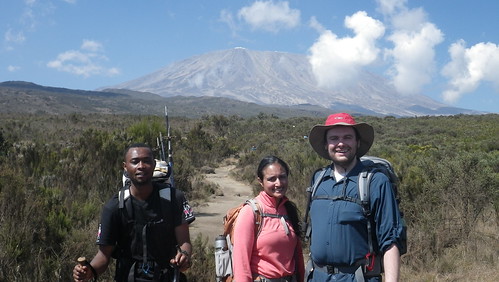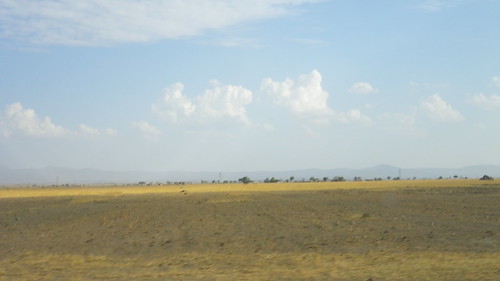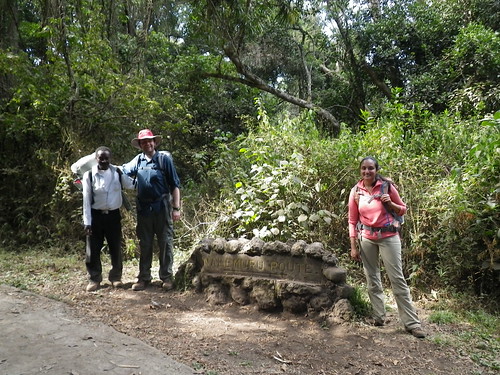Eunice wanted me to tag her as the baby elephant from a previous post. Unfortunately, I don't know how to do this, so consider this a "verbal" tag.
Resha wishes me to inform everyone that photos of me doing stupid things are "glamour shots." They will be so labeled from now on.
Back to the main event...

... that's Resha at the Marangu gate reception area, the beginning (and also the end) of our journey. Look how happy (and clean) she is. Regardless of which route you take up the mountain, everyone must check-in at the Marangu gate. But that's getting a bit ahead of ourselves.
Our trek actually began the day before when we said goodbye to David (and Hans - more on him in the food section), took a "pool shower," and then had an audience with Ronald, our lead guide. That's Ronald on the left...

... in front of that awesome view of Kibo, the largest of Mount Kilimanjaro's three peaks (see my first post concerning the general topography of Kili).
To say that David and Ronald were different is an understatement. Where David was loud and relatively verbose, Ronald was quiet and introverted. Where you immediately trusted David with your life, Ronald had a crafty/shifty air about him. Whereas David's English was impeccable, Ronald had a good but much more functional grasp of the language. This issue came up immediately, as after our experiences with public bathrooms on the safari, we decided we wanted (and were willing to pay extra for) a dedicated portable private bathroom carried by the affectionately named "poo porter." We asked Ronald about this, and he said that there indeed would be a "poo porter." We later found out, however, that there was a misunderstanding, and he thought we asked whether there would be bathrooms on the route. Oy vey! (There will be a whole future post on bathrooms. It's that important.)
In other words, it was immediately apparent that the Kilimanjaro portion of our journey was going to be completely different from our safari portion. But I guess that should have been self-evident.
So, after briefing us, Ronald arrived early the next morning to pick us up with another driver, Godwin. Godwin was an affable safari guide who we exchanged pleasantries with while Ronald loaded our equipment onto the vehicle. The most prominent thing that I remember Godwin saying was that he became a safari tour guide because after climbing Kilimanjaro twice, he thought anyone who would do this was crazy. Not exactly the paradigm of confidence.
After our stuff was loaded, we started our journey by picking up Goodluck (cook) and Mohamedy (waiter) in Arusha. Goodluck had to be in his mid-twenties at the latest, while Modi (what they called Mohamedy) was a little bit older. Goodluck was very cheerful with the biggest smile you had ever seen. His English was decent, and you could tell he was an extremely bright guy. Modi, on the other hand, was very nice, polite, and competent, but his English was pretty bad, and he also wasn't the sharpest tool in the shed. Case in point, this is a picture of Modi...

... with the reason his face is huge is because we asked him to take a photo of us, but he didn't know which way to point the camera. He was also the first muslim we met in Tanzania, where they are a sizeable minority. I had mentioned before in a previous post, that our taxi driver was from Arusha, and he had taught us a couple Swahili words, among them was salama, which we were told was one of the ways of saying "hello" or "greetings." Well, while we were talking to Hans (our cook on the safari) we mentioned this, and he asked what we had learned. We told him, and he understood (and was mildly amused) by most of what we had learned, but a quizzical expression came across his face when we said "salama." After repeating the word to himself a few times, however, he said "ah, salama. The man who taught you that must have been muslim," which then immediately made sense to me, as "salam" means "peace" in Arabic. The main reason I knew that was because I read in my book that Dar es Salaam, the largest city in Tanzania, means "house of peace" in Arabic. So there you go.
Anyways, from Arusha we journeyed past Kilimanjaro Airport and Moshi. The drive up to that point was uneventful, as it was flat, dry, and straight, with fallow fields dotting the landscape, broken up only by the occasional hut and herd of cows tended by a group of Maasai.

It was right after Moshi and on the way to Marangu, however, where things got interesting.
(Map courtesy of GrantToursandTravel.com)
While I will explain in more detail later, basically, we began the day in Arusha on the left, drove about an hour and a half to Moshi, drove another hour to Marangu, and then drove two hours north around the right side of the mountain until we reached Rongai, which is right on the Kenya border.
From Moshi, we began ascending the mountain, and the dry savannah gave way to a winding road surrounded by lush green forests, with every inch of the road populated by homes and stores of the native Chagga. The most interesting point of journey was when we drove through Marangu on a market day, as we saw hundreds of men and women walking down the road bringing produce to sell, with the most impressive being the women balancing 3-4 meter stalks of sugar cane on their heads.
We continued the drive up to Marangu gate, only stopping once for Goodluck to jump out of the car and run into a random house. Ronald told us it was his parent's home where he was picking up his supplies, and that we would pick him up when came back down. At the gate, an armed guard eyeballed us in the car, and then let us through, upon which we pulled into a large parking lot on the left.
From this point on, there was a bit of an uncomfortable separation between us and the guides/porters, very much facilitated by the way the park operated. While on safari, us and David had pretty much eaten the same food, shared the same tent quarters, and occupied the same space, on Kilimanjaro, there was a very clear delineation where we could go, and where the guide/porters could go. What brought this to my mind was the "tourists only" bathroom at Marangu gate, but no similar counterpart of the guides/porters. The "tourists only" bathroom had flush toilets and even seemed to be a bit air conditioned. The rest of the gate area was also very nice, with a large multi-tiered wooden deck supporting the reception area...

... and a general store of sorts right across from it that sold trinkets, postcards, snacks, and cold beverages (very important later).
After about thirty minutes, Ronald said he had finished all of the paperwork, and so we went back to the vehicle to depart. When we got there, we saw that another older man had joined us, Jonas. Ronald introduced him as our second tour guide. This is Jonas on the far left...

... and he is hands-down our favorite person on the mountain crew, and came very close to eclipsing David. But not quite.
So what makes Jonas so awesome? Well, first of all, he is sixty years old. That's right, he's a SIXTY YEAR OLD MOUNTAIN TOUR GUIDE. Born on the slopes of Kilimanjaro, he said he first climbed all the way to the top when he was 16, and since then, he has been all the way to the top so many times, he has lost count. When I asked for a general estimate, he thought about it for awhile before answering "more than one hundred." Daaaaaaamn.
Next, he is small. In fact, I think it is because he is so small that I never saw him eat or drink anything except for the energy snacks and candy we had brought with us. And yet, he never showed the slightest bit of hunger, thirst, fatigue, sickness, or boredom.
Relatedly, Jonas was the only one who never left our side on the entire trip (even more than Ronald - more on that later), always keeping a comfortable pace and making sure we were okay, and never judging, even when he must have been completely frustrated by our ridiculously slow pace. In fact, there are many times where he would effortlessly walk ahead, look back, see how far behind we were, and then come back. It's like he was floating on air.
Finally, we loved Jonas even though his English wasn't particularly great. He knew enough mountain terminology and conversation to get by, but it was difficult for us to even get the above information out of him. One of the more interesting things we did find out, however, was that he also spoke a little German from the remnants of the days when the Kaiser was in charge. Fascinating.
Anyways, at that point we all stuffed into the car (pretty crowded at this point) and began the long drive from the southeast side of Kilimanjaro to the northeast side, and the beginning our route, the Rongai route.
(Map courtesy of GrantToursandTravel.com)
You could tell this part of the road was a new construction, as the sides of the mountain had been freshly carved out, and there was construction vehicles everywhere. We stopped at a town almost exactly half way from Marangu to Rongai to have lunch. We pulled into an alley, and walked about twenty meters to a bunch of covered picnic tables of what I assume was a restaurant. We got some looks from some gentlemen sitting at other tables having a few beers, but they quickly went back to their conversation. There we ate our box lunches. I found it a bit odd that we would eat lunches in someone else's restaurant without ordering anything, but no one seemed to say anything.
After lunch, we drove to the Rongai gate, where we met the rest of our crew. Fourteen (yes, FOURTEEN) in all. Seventeen, if you included us. And a motley crue it was.

More about them, and the actually beginning of our climb, next week...

Woo hoo! I'm a baby elephant :)
ReplyDelete